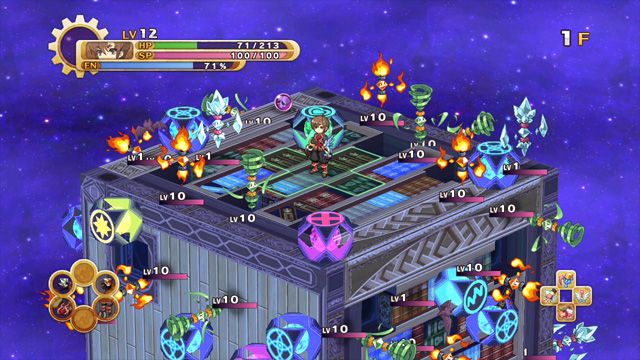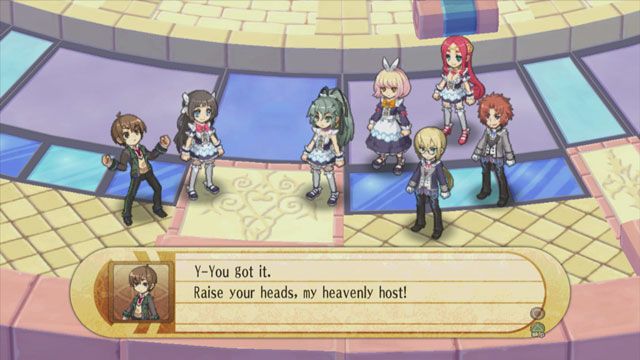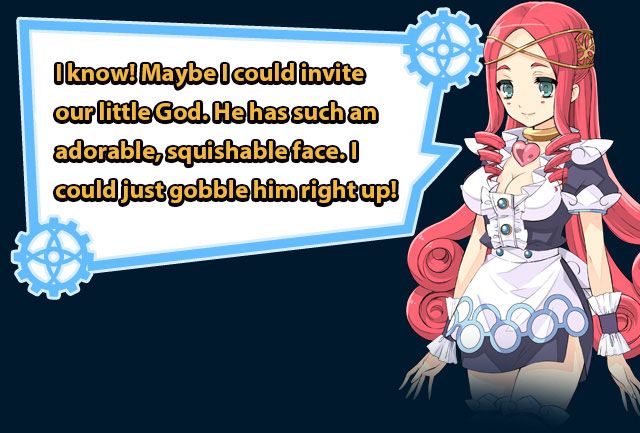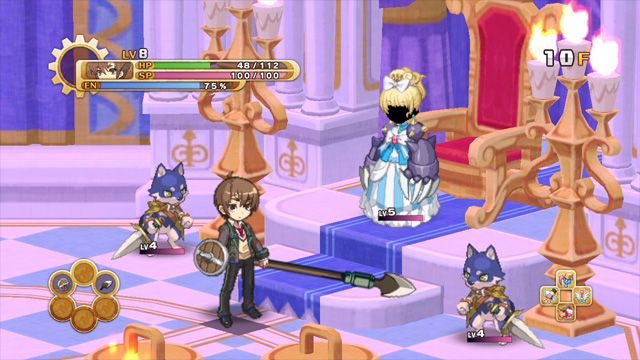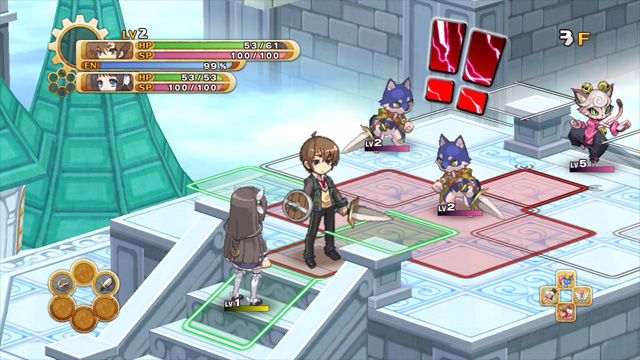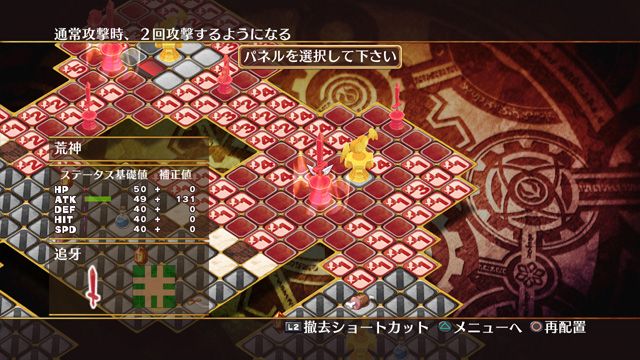Have you ever wondered "What is it like to be God?"
The developers at Nippon Ichi Software have never shied away from using religion as source material for content and their newest title, Guided Fate Paradox, does just that: puts players into shoes of a schoolboy named Renya, who through some divine lottery has won the Almighty power of God. Call it profound or blasphemous, Guided Fate Paradox takes the premise of playing god and combines it with some mechanics and ideas found in previous titles like the Disgaea series to make for an interesting new game. Playing God may not be the most simple or smooth experience when exploring the world of Guided Fate Paradox, but it's definitely one hell of a ride.
Yes, pun intended.
In fact, the first thing fans of Nippon Ichi Software games will notice is the humor, the puns, and the randomness, something that is as integral to their titles as the mechanics found within. For what could be such a serious and thought-provoking experience, Guided Fate Paradox brings constant comedy to the story, and there's nothing wrong with that. In fact, the game shines for its humor and superb voice-acting, if not always for its overall story.
This levity permeates many aspects of the game. When a player wants to return to the title screen and leave the game, his only option is to press the "Give Up" option in the menu. When the player is done meeting the initial characters of the game and ready to take on the tutorial, his faithful assistant, Lilliel, cheerfully breaks the fourth wall, replying with "Allow me to advance the story!" When about to start the tutorial, you're asked if you have any experience as God before, to which you can answer "Of course not!" to take on the tutorial, or to skip it choose the option "I'm a black belt in God-kwon-do!"
There are also all kinds of other jokes in the game, including har-har tongue-in-cheek references, like a zombie soldier being asked by his sergeant "Then when will you be ready!? Dawn? The day after tomorrow? Perhaps 28 days? Maybe 28 weeks? In another year?" and more adult humor, like meeting a character with a shapely figure and being described as having "Old Testament"-sized...assets.
But not everything is fun and games in Guided Fate Paradox. While humorous, there are some creepy and dark plots for Renya to contend with, including the running gag that if Renya doesn't continue his duties as God, he will be consumed by some unknown assailant. Turns out early on that that's not too much of a gag.
So what kind of God are you?
Renya at first glance seems like your run-of-the-mill Japanese protagonist, whom either fall into the annoyingly cheerful and unrelentingly positive category, or depressingly mellow, shy and introverted category. Renya falls into the latter category. He's never won a single thing in his, but after 17 years of being unlucky, he's won the grandest prize: the power of God.
Taken to Celestia by Lilliel, an angel-in-training and the newest personal assistant to God, Renya finds out that he's not the first personal to fill the shoes of God. Worst, his other six angel attendants aren't as innocent as the endlessly bubbly and innocent Lilliel.
Thankfully, this diverse cast of characters mixes your typical slew of anime tropes for a fun variety of personalities. Renya himself very quickly shows off a wry sense of humor and sarcastic wit; Lilliel, whose last name of Saotome means "maiden," combines the cheerful and naive virginal character with weird quirks, like her occasional "Muah-ha-ha!" laugh. Cheriel, the aforementioned busty angel, has a questionable origin and constantly offers lewd or subtly threatening suggestions; Lanael, who at first looks childlike and pure with her teddy bear in tow, is known as the "deluded angel" because of her tendency to make up names for herself like the "Dead End Trigger" or the "Riot Commander,"and having an evil glare and dark thoughts.
Celestia itself is a weird kind of Heaven that definitely fits in with the depictions of Heaven in previous NIS titles: bright, shining, but foreboding and slightly austere. Monsters litter Celestia as much as they do the Netherworld, and these servants are knowingly enslaved with the "rings" (read: halos) above their heads, but are all surprisingly affable and cheeky, and have odd names like "Cheaps Sweets," "Coon," and "Forever Rappin'."
Now, you may have been wondering just what is it that a God does. The answer is simple: answer prayers.
Guided Fate Paradox tasks players with answering the prayers of anyone in the universe...which includes not only humans, but fairy tale characters, the undead, and more. To accomplish this task, the angels make use of the Fate Revolution Circuit, a machine that collects and filter the 100 million wishes that come every hour and every day of the week, and offer those missions to God that correspond to his current ability level. There's only one golden rule: once a wish is selected, it cannot be skipped; it must be completed.
Answering prayers isn't as simple as you think. As Lilliel explains, Renya can't affect the regular universe without making his presence overtly known. While it may make sense for God to reinforce the faith of his followers by performing miracles, it would also encourage people to try less at accomplishing their own goals, and to not just pray to God to do everything for him. And so the Fate Revolution Circuit takes the prayer, the praying individual, and their Original World, and makes a copy of it, the Copy World. Here, you as God may enter and help the individual change their fate. When completed, the fate will carry over into the Original World, and your job will be done.
But changing fates isn't that easy. While in the Copy World Aberrations, or monsters, will appear, attempting to prevent you from changing the fate of the individual. These aberrations actually represent and embody the thoughts and feelings of the individual, the negative part of them that prevents them from changing their own fate. It's an interesting idea to think of a God of free will fighting fate so directly, and this is the idea that pretty much makes Guided Fate Paradox's concept work.
What makes Guided Fate Paradox very different from and yet very similar to some of its predecessors is its mechanics. Guided Fate Paradox is both a roguelike game and a TRPG, combining the idea of exploring randomly generated dungeons with an isometric and tactical view. But instead of having characters that have certain "Move" stats and choosing a tile for them to venture to, players move Renya freely one tile at a time. For action you take, others on the board take an action, with the explanation being that only when God moves can anything else.
Still, this free-roam capability is superficial, since, once again, players move on an isometric grid one tile at a time, and still have to face approaching enemies, select attacks from certain distances, and attempt to flank enemies. New to most TRPGs is the idea that enemies have a field of view, which you can avoid to remain undetected, and upon death enemies can "scream," which alerts nearby unalerted foes to your presence.
Moving in dungeons also takes up energy, or EN, which can be maintained with food. If it reaches zero, your health will begin to drop too. If your HP reaches zero, Renya will be forced to exit the Fate Revolution Circuit and return to Celestia.
Here's where the game gets a little complicated: should Renya ever get booted out of the Fate Revolution Circuit, his level will return to 1, he will lose half of his money, and he will lose all of his items. It's a steep penalty that will keep players on their toes, but can be avoided by depositing your money into a bank before venturing into the Circuit, by using the "Exit" item to safely leave the Copy World, and by grinding and leveling up.
Here's where Guided Fate Paradox continues to get complicated: losing your life in a dungeon doesn't make you lose all your progress. Instead, it gets added to the "Total Level" of the dungeon, which, once completed, will add bonus XP to your stats. Here's another whammy: successfully completing a level will still revert your level back to 1, but with the idea that your base stats rise with progress. So even though your level reads as "1" doesn't mean your stats will be that low. It's a new take on the Disgaea reincarnation/transmigration mechanic, starting over at a lower level but with higher stats, so that when you level up again your stats get up to insane levels (for the Disgaea uninitiated: the franchise is known for offering the freedom to level up your character to 999, with corresponding maxed out stats, if you have the heart, patience and time for it).
//www.youtube.com/embed/SFDq9y97W8o?feature=player_embedded
Stat-building also comes with the Divinigram and "bursting" weapons. Every time you use a weapon, you fill a percentage of its "Burst" meter. When the weapon reaches 100%, it loses power. But once you take it to the Blacksmith, you can use the Burst status to increase its power past its initial limits. Every time you use it afterwards, it will take a little longer to burst, but with the promise of being even stronger.
Having burst items also encourages players to carry and try out a variety of weapons, of which the game has plenty: simple daggers to attack nearby enemies with, a ball and chain that you can hit far off enemies with, a flowing cape that can blow enemies back a few tiles, wands for magical elemental spells, tank treads to move with, and much, much more. These items, once equipped, adorn your characters while on the battlefield, allowing for some really interesting, cool, curious and whacky combinations. Using these weapons allow for Divine Releases, attacks that do extra damage or special effects; using more than one of the same item (like two daggers or two guns) creates a more fantastic Divine Release attack.
Coming back to the Divinigram, every time you burst a weapon, you unlock a "Holy Icon:" head items offer HIT (or accuracy) icons, arm items offer ATK (or attack damage) icons, shields and leg items offer DEF (or defense) icons, and miscellanious items offer SPD (or evasion) icons. These icons can be placed on the Divinigram, which bears resemblance to Final Fantasy XII's License Board, and allows players to increase their base stats. Players can later unlock Holy Artifacts, which further enhance abilities or offer unique skills, like a larger pouch for increased inventory, additional experience points, and more. But these artifacts have to be placed over a specific amount of Holy Icons, and negates their effects. The stronger the ability, the more space required.
This seems like a lot, I'm sure. I haven't even mentioned Renya's God Mode, ability to use special items like "Sleep Orbs" and "Paralyze Orbs," or his ability to pick up and throw enemies away from him. But believe me when I say it's very easy to pick up during gameplay, and it lends itself to the game's replayability. All of these mechanics and sub-mechanics give you a reason to replay certain dungeons, which always have different layouts (if familiar designs) due to their randomly generated nature. And playing these dungeons take up the bulk of the gameplay, since every part of the story involves solving wishes by fighting through the Copy World.
Thankfully, Renya not only has all of these abilities but his angels to rely on, each of which can be fully customized, given orders (to direct the A.I.) and offer their own unique abilities that are appropriate for certain worlds. These worlds offer some fresh takes on levels, including the idea of moving platforms, three dimension platforms, underwater levels (where you can use torpedoes to speed up movement across the board), and giant enemies that take up a large portion of the game.
And while you'll take on largely the same kind of Aberrations across the levels, there's a decent amount of variety in how to approach engagements: Shield Snails, for example, have a shield protecting their front and must be attacked from behind to ensure defeat. Undead enemies will continue to resurrect until you throw a gravestone on them, which kills them permanently. Medusas, upon defeat, will turn anyone nearby, ally and enemy alike, into stone. Even more, the very end of each dungeon typically includes a major boss fight, which can range from fighting a large group of enemies to fighting "oversized," titanic bosses.
//www.youtube.com/embed/Z8ALP-4gC5k?feature=player_embedded
But how does it all come together?
Unfortunately, there's a small balancing issue when it comes to playing Guided Fate Paradox. While the humor and voice-acting are, as usual, very enjoyable, the overall script is not always very enjoyable. Cutscenes in-between battles are either done through the in-game isometric view or motion-comic like art typical in most Japanese games, accompanied by blocks of text. Nothing is wrong with this. It's just the pace of the story, which feels like it's going a few miles an hour, that makes the cutscenes less appealing. It can be very tempting to press "X" to get each line over with, or press "Triangle" to skip the entire thing. Still, the stories are interesting, especially the premises, so it just depends on how patient you are and how interested you are in the characters. Besides the individual prayers, there's an underlying plot involving devils attempting an attack on Celestia and the angels having their own conspiracies and plots in motion that will keep you chugging along as well.
The controls can also take a little getting used to, with movement regulated solely to the D-Pad, the analogs used for bringing up menus like hotkeys on a PC game, and regular attacks done through the "X" button. Players can also move in any direction, but must press "Square" to change which way they're facing, which can be confusing at times and cause players to miss a turn to attacking a nearby foe. Also, when exploring dungeons, there are little walkways that connect larger areas, and when entering them the field of view is limited, with the screen becoming a shadow around your characters. It's very weird, considering the stages aren't generally too large, and games like Disgaea have had similar-sized stages for years without this mechanic. It doesn't build suspense or add to the experience in any way, especially since your map shows when and where enemies randomly appear.
Still, Nippon Ichi Software knew who they were making this game for, and Guided Fate Paradox will definitely appeal to fans of their other games, especially with the similar mechanics, flashy attacks, easter egg items, cameos (like NIS's unofficial mascot, the hidden character Asagi) and whacky, fun black humor. For others, the game may be a little intimidating to jump into, but if you have a lot of time to devote to a single game (which, I'd like to add, would lend itself well to the PS Vita's mobile nature) and you enjoy unique Japanese experiences, Guided Fate Paradox is definitely worth a try.
For a closer look at the game, check out the gallery below; for more details and videos on the game, check out all of our Guided Fate Paradox news.

